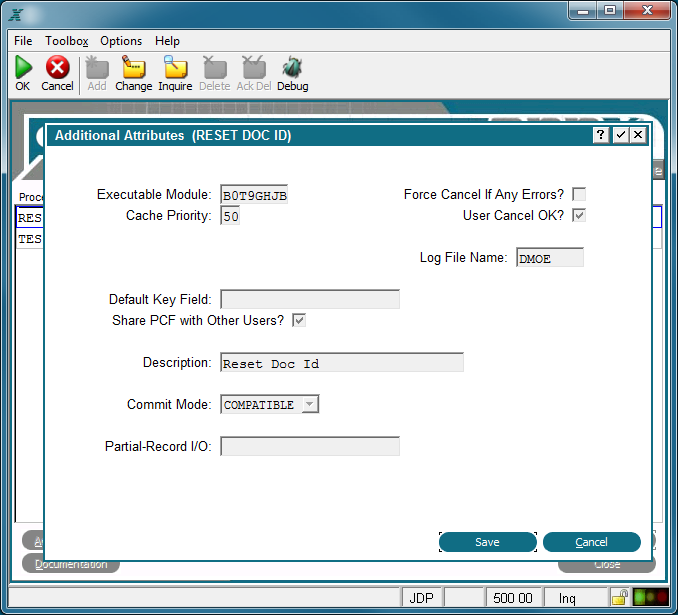Chapter 3-8: Update Processes |
Update Process Additional Attributes Option The Additional Attributes option accesses the Update Process Additional Attributes overlay, shown below, from which you can alter the standard EM attributes.
Update Processes Additional Attributes Overlay The update Additional Attributes overlay contains the following fields: Executable Module displays the name of the executable module (EM) that is automatically generated by APPX. APPX derives the file name from the date and time the currently selected update process was added. The name consists of a unique string of eight alphanumeric characters and cannot be changed. If APPX finds it necessary to recreate the EM, the new EM retains the same file name.
Force Cancel if Any Errors? Controls whether or not the user is forced to cancel the process if any errors are written to the log file. If 'yes' Cache Priority establishes the likelihood that the process will remain in memory after execution, relative to other processes that the user has also completed executing. A process with a cache priority of 99 is most likely to remain in memory. A process with a cache priority of 1 is least likely to remain in memory. A cache priority of 0 indicates that the process is never cached. The default is 50. This field is common to the Additional Attributes overlay for all types of processes. See Process Definition, for more information.
User Cancel OK? contains either a 'yes' Log File Name establishes the name of the file that is used to store the list of error and warning messages generated during the execution of the update process family. If necessary to guarantee uniqueness, APPX may append one or more characters to the value entered here, or replace one or more of the ending characters. This field may contain up to eight alphanumeric characters. If two or more update processes in the same subprocess family are defined with identical Log File Name values, the processes share a common log file. They print as a single log, with continuous page numbers. If this specification is blank, APPX uses the last Log File Name that is active within the subprocess family. Refer to Overview of Appx Processes for a definition of a subprocess family. Default Key Field designates the specific keypath to the PCF that is used in executing the defined update process. If you did not link this update process to a query process, the key determines the order the records process in. A default keypath that is defined for the invocation of a child process, if any, overrides this specification.
Share PCF With Other Users? contains either 'yes' Description is incorporated in the message that displays on the screen when the currently selected update process is compiling. It is used to communicate with users since it provides a more descriptive and easily understood alternative to Process Name, which is the default if this field is left blank. See Process Definition, for more information. Commit Mode controls the commit mode for a process and can be selected from a drop-down list of available options. Commit Mode determines those points in time when APPX will commit changes made to the tables stored within an RDBMS. It is only applicable in conjunction with an RDBMS; it has no effect with APPXIO. Also, not all File Managers support this feature. Although initially set here for the process, it can be added or overridden by use of predefined field COMMIT MODE. The following options are available: COMPATIBLE. Changes are committed as soon as all locks are freed. This provides maximum compatibility between APPXIO files and RDBMS tables.
AUTOCOMMIT*. APPX will commit each modification as it is made. PCF CYCLE. APPX will commit modifications as each PCF record is processed. END. APPX will only commit modifications at the end of the process family. MANUAL. APPX will not automatically commit changes. You must use the COMMIT statement to do so. Partial-Record I/O is used to specify a field from the PCF file so that instead of operating on the entire PCF record, APPX operates on the designated field only. If the field is a group header, then I/O will be performed on all members of the group. Utilizing partial-record I/O can greatly improve performance when the PCF is a table in an RDBMS. This is especially true when the table contains many columns, but relatively few are being utilized by the process. The scan option is available for field selection. |
Application Design Manual "Powered by Appx Software"1096 ©2006 By APPX Software, Inc. All Rights Reserved |
